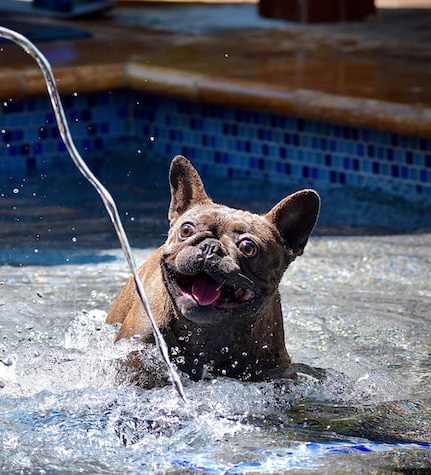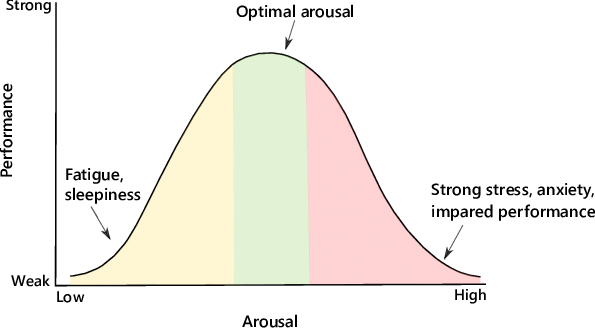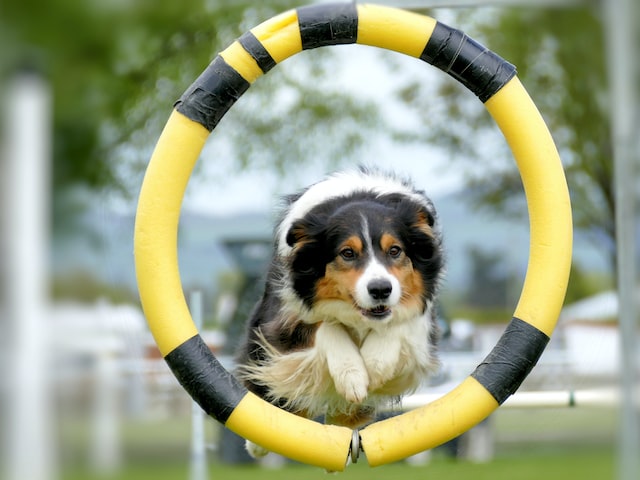Canine Arousal: Optimal Training Zone vs Over Arousal
Sometimes, environmental influences can be too stimulating for our dogs, resulting in their arousal rising beyond the limit where they can control their behaviour. This article discusses arousal levels, how hypo and hyper-arousal manifest themselves, and what the dog and owner can do to return arousal to an optimal level.
What Is Arousal Level in Dogs?
In short, arousal is a dog's responsiveness to environmental stimuli. These stimuli can be caused by people, other dogs, animals, etc., or by their owners. One of the characteristics of arousal is that it's cumulative; that is, several consecutive events will gradually increase the arousal level, and once the threshold is passed, the dog has difficulty controlling its behaviour; this is known as over-arousal or over-threshold.
Arousal involves complex internal interactions, starting with the brain (especially the reticular activating system) and other body parts that react to brain signals. Trigger stacking leads to a dog going ‘over threshold’, resulting in unpredictable or unwanted behaviour. Thus, arousal has psychological and physiological effects on the dog, manifested by its reactions to the environment.
Of course, in addition to the dog's health, high or low arousal affects the interaction with the owner and other people. Dogs who repeatedly show excessive arousal without the ability to work cooperatively with the owner or trainer can be frustrating. Handlers can work on techniques to reduce arousal levels and bring the dogs back to an emotional state where they can think and make better choices.
A Happy Dog or Hyper-aroused?

A distinction should be made between dogs with a good "drive"; active, interested, and focused, as this trait can be highly valued, especially in dog sports. It is problematic when the arousal level is too high, affecting the dog’s ability to maintain focus, thus becoming easily distracted or making poor choices. During training or play, dogs in a state of hyperarousal move quickly from one task to another without really engaging in the task.
What happens in the dog's system is a whole series of reactions that connect and build up the increase in arousal, creating that state of hyperarousal which we can ultimately see through overexcited reactions and the dog's inability to control itself.
Hyperarousal: High Arousal Level
Hyperarousal creates an excess of physical and emotional energy in the dog's body. When the dog experiences a state of hyper-arousal they act impulsively and lack self-control. Owners must recognise this state in their dogs; acute injuries are more likely to happen in this state, longer-term health effects can occur when dogs cannot moderate their arousal level, and owners lack control of their dogs.
Over-aroused dogs might exhibit behaviour such as excessive barking at a passer-by, which is then redirected to a nearby dog when the person leaves. This can lead to conflicts with both humans and dogs. Without a means to release the energy created in this state, a dog's nervous system may remain on high alert for days, with small events triggering significant reactions and further delaying the return to normalcy.
Hyperarousal also can mask injuries or pain; at home, the dog may limp or sulk, but when in the park, it seems as if our dog is miraculously recovered. This phenomenon occurs due to the heightened state of arousal overriding essential communication from the somatic nervous system. In this state, the dog is blissfully unaware that its body hurts—which increases the risk of further injury. Once the dog’s level of arousal returns to a more manageable state, they begin to feel their ailments, which is why we see them limping at home.
Hypo-arousal: Low Arousal Level
Contrary to hyperarousal, there is also hypo-arousal, a state of low-level arousal to environmental stimuli. Extreme hypo-arousal can be manifested through deep fear responses that shut down or restrict the dog's ability to process information. A less severe form of hypo-arousal is seen when the dog is inactivity due to physical or emotional reasons. Dogs need regular exercise to keep their body and mind healthy; a dog who is difficult to motivate may need extra care to prevent its health from being compromised.
Arousal Axis

James Russell, a neuroscientist from the USA, developed the Circumplex Model of Emotions (more commonly known as the Circumplex Model of Affect) to show how emotional states are related.
This model proves that affective states are a result of the behaviour of two neuropsychological systems that are independent, the arousal system and the emotional valence system. The axis of arousal, located vertically on the model, ranges from zero arousal to a high level of arousal. The horizontally drawn valence axis ranges from positive to negative. When observing the emotions this way, each one is described using a dimension of unpleasantness/pleasantness (positive or negative valence) and a dimension of high arousal/low arousal. With this model, emotional states can be displayed at any level of valence and arousal, as they can also be in the middle, in a neutral position.
Clear emotions evoked or directed by objects, words, and environment can be placed on the circumplex model, according to their levels of arousal and pleasure. As emotions are subjective experiences, the same stimuli for two individuals can result in a different emotional state, depending on the level of arousal. The same is true for the individual's reaction to the same stimuli at different times, which can diverge depending on whether the arousal is high or low.
The Training Zone

The Yerkes-Dodson Law describes how arousal works well, originally developed by psychologists Robert M. Yerkes and John Dillingham Dodson. This law describes the relationship between pressure/arousal and performance. Performance increases as arousal increases until a dog reaches an optimal level. After that, every additional arousal pushes the dog over the threshold, the dog becomes overstimulated, and the success of the performance decreases.
Above threshold, reactions can become tumultuous even to minor positive or negative triggers. This is because arousal is cumulative, and once it crosses the threshold, it takes time (up to 72 hours) for the dogs nervous system to calm down again and bring arousal back to an optimal level.
All dogs are individuals, some are more prone to states of hypo or hyperarousal than others; some will cross the threshold very quickly, while for others, the build-up to the point of hyperarousal will be slower. Once their arousal level exceeds the effective training zone, how they respond to that state and how long it takes them to relax will also be affected by their own skill, training, and nature.
Arousal State
Dogs that have problems with the ability to regulate their arousal levels are also very likely to have poor impulse control. Similar to Canine Emotional Regulation issues, arousal regulation issues can lead to emotional and neurological dysfunctions. Being in a continuous state of high arousal prevents the body from engaging in repair tasks which leads to chronic health issues.
Owners can learn to recognise the indicators of a highly aroused dog and then take action to help their dog move through the arousal axis back to a state where the body can relax.
A dog in a state of hyperarousal may exhibit some of these signs:
- Dilated pupils
- Repeatedly jumping around
- Tense body ready to sprint
- Panting
- Relentless barking
- Spinning in circles
- A fast heart rate
- High respiration rate
- Teeth chattering
- Generally poor impulse control
Internal Effects of Arousal State
We have already mentioned the influence of high arousal on dogs' physiological and psychological states. Generally, a hyperaroused dog will have a rapid heart rate and high blood pressure rate and show signs of rapid breathing. In such a state, they release high levels of stress hormones. Their impulse control over stimuli can be weakened, which is why they are often very easily distracted, especially in a dynamic environment.
If chronic high arousal is not treated, the dog may become frustrated, which may lead to destructive behaviour, and, in severe cases, even aggressive behaviour.
State of Arousal and Learning
The best learning results will be achieved when the dog is neither in a state of hyperarousal nor hypoarousal. As arousal increases (and decreases) gradually, the ability to learn increases and decreases.
Difficulties that could be encountered during learning and training in a dog with increased arousal are:
- The inability to learn behaviours that involve greater focus and precision
- The inability to perform a specific behaviour, or to stop performing it
- The inability to remain focused on the task, or are easily distracted by environmental stimuli
- Ignoring commands
For this reason, in dogs with increased arousal, we first need to help them move through the levels of arousal, gradually introducing them to a state/zone in which they will be able to train. Implement short training sessions that teach the dog how to move up in arousal and then back down again, ending the session in a neutral level of arousal will help the dog to learn arousal regulation skills.
In addition to being aware of the arousal level, it's essential to keep in mind the age of the dog we are working with. Younger dogs will have more significant problems controlling their accumulated energy, so we need to adjust our approach to them accordingly.
Environment Distractions: Detect Them

Identifying our dog’s triggers, or what causes them to move into a state of hyperarousal is the first step in helping them.
When taking the dog for a walk or to a dog park, and they show those apparent signs of high arousal mentioned earlier, we should determine what the triggering thing or event was.
Dogs who lack physical exercise and mental stimulation may be more easily triggered and overwhelmed by the suddenly stimulating environment when taken out for exercise. Our pets need to move regularly, and their minds need proper mental exercise; without adequate stimulation, there may be many environmental triggers that initiate a hyperarousal state.
Strategic games can be a great way to lower arousal levels and create space for learning; you may even notice that dogs engaged in scenting games are less likely to notice those environmental distractions that previously triggered them.
Situations That Adversely Affect the Arousal
We all love when our dog is happy and playful. But if we notice that specific actions have a negative effect causing a state of hyperarousal, it’s necessary to set clear boundaries. Owners often overexpose their dogs to situations that are too exciting. Playing a game that makes your dog overly excited (e.g. Frisbee) for several days in a row will create a state of permanent excitement in the dog. Dogs can become passionate about activities, sometimes to the point of obsession. This is not healthy for the dog.
Sara Reusche, an experienced dog trainer and author of the article "Too Much of a Good Thing: Over-excitement in Exercise", advises that it’s vital to become aware of the amount of exposure to such overstimulating activities and, if necessary, reduce them and replace them with activities that will still provide physical activity but not so stimulating.
Whole Energy Body Balance

Purposeful, soothing touch is often overlooked when we talk about dog care, as is the connection with dogs on a cognitive, neurological, and emotional level. Whole Energy Body Balance (WEBB) has precisely this type of approach, allowing the therapist to fully attune to their patients and react to the most subtle sign of communication. This therapy works on calming the nervous system, which is exactly what dogs in a state of hyperarousal need. Learn more about the holistic WEBB treatment and contact us for more information about, or to book a WEBB session appointment.
Using Arousal Level to Your Advantage During Your Fitness Training Sessions
- Work Smarter Not Harder
- There is a widespread but potentially wrong opinion that the best way to tire out high-energy dogs is through endless games of fetch, running, treadmill exercises, etc. If this energy is an indicator of hyperarousal, putting the dog under an even stronger influence of stimuli creates an increased risk of injury or harm. Therefore, teaching dogs how to calm down is more important than physically tiring them out. Dogs need an off-switch.The ideal exercises in such a situation will help the dog gain and maintain focus. This will help your dog more easily balance the arousal level, remain calm and not have dramatic oscillations of arousal depending on external triggers. Dogs who work on successfully maintaining focus will make decisions more easily during high arousal periods. This is a better solution than trying to tire them out to the point where they become overly fatigued.
- Consider the Arousal Levels
- It was mentioned earlier that arousal is cumulative; that is, it builds up with each increased stimulus from the environment. If it's not regulated, it can cross the threshold at which the dog reacts impulsively. That's why we should consider the level of arousal our dog is in and consider how close or far it is from crossing that threshold.Then, it's necessary to work on desensitising the dog to environmental triggers (those we detected beforehand, of course). This method presents these triggers to the dog at a lower intensity. In some situations, it might be not easy to think about reducing their intensity so that the dog is not immediately under a strong influence. This approach takes time but can ultimately lead to great results.
- Aim for the Training Zone
- Understanding arousal levels and finding a method to efficiently work on raising or lowering them is a vital step in dog training. When the dog is in the training zone, it should be introduced to higher and lower doses of arousal because different tasks require different energy levels. The more complex the task, the calmer the dog needs to be (that is, lower arousal) to learn and perform the job successfully.
Conclusion
Owners can foster stronger relationships with their dogs by understanding their state of arousal and what triggers push them over the threshold. By teaching their dogs to easily move through states of arousal and increase the tolerance of the optimal training zone, the dog’s emotional and physical health will be positively benefited.
A lack of self-control, anxiety and aggression towards strangers may all be indicators of an inability to regulate arousal levels. For both you and your dog enjoying your time together will be spent more carefree when arousal is regulated.





Hounds in Homes (Trisha)
2023-07-16 23:26
Love this article, so helpful!
Meri Hood
2024-09-17 16:18
To the caninebodybalance.com.au administrator, Thanks for the great post!
Sheida
2025-01-17 05:15
I’m a novice when it comes to animal training and I truly love and respect them. Recently I fostered, then adopted 2 beautiful dogs who have been very anxious and shut down due to their horrible past experiences and I really want to help them to be happy and enjoy life with me, so this information is so great and I’m so grateful for it. I would love to register for a complete course to learn more and help more animals in future. Thank you so much.